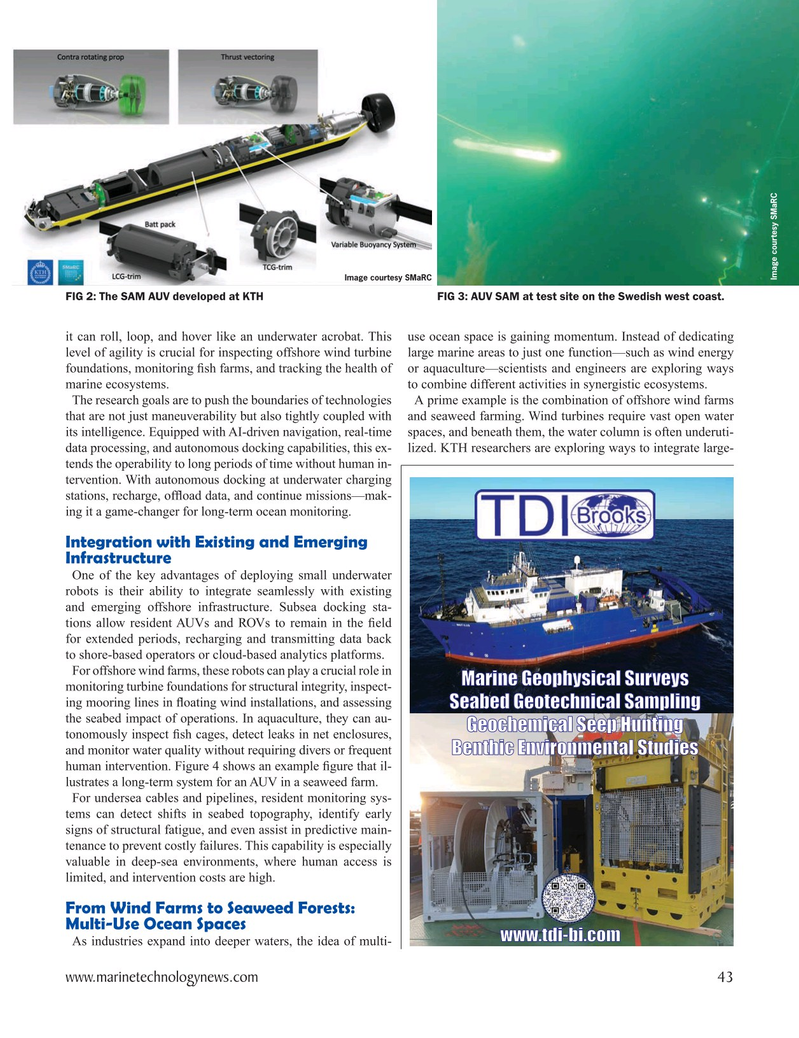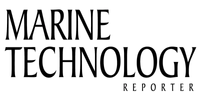
Page 43: of Marine Technology Magazine (March 2025)
Read this page in Pdf, Flash or Html5 edition of March 2025 Marine Technology Magazine
Image courtesy SMaRC
Image courtesy SMaRC
FIG 2: The SAM AUV developed at KTH FIG 3: AUV SAM at test site on the Swedish west coast.
it can roll, loop, and hover like an underwater acrobat. This use ocean space is gaining momentum. Instead of dedicating level of agility is crucial for inspecting offshore wind turbine large marine areas to just one function—such as wind energy foundations, monitoring ? sh farms, and tracking the health of or aquaculture—scientists and engineers are exploring ways marine ecosystems. to combine different activities in synergistic ecosystems.
The research goals are to push the boundaries of technologies A prime example is the combination of offshore wind farms that are not just maneuverability but also tightly coupled with and seaweed farming. Wind turbines require vast open water its intelligence. Equipped with AI-driven navigation, real-time spaces, and beneath them, the water column is often underuti- data processing, and autonomous docking capabilities, this ex- lized. KTH researchers are exploring ways to integrate large- tends the operability to long periods of time without human in- tervention. With autonomous docking at underwater charging stations, recharge, of? oad data, and continue missions—mak- ing it a game-changer for long-term ocean monitoring.
Integration with Existing and Emerging
Infrastructure
One of the key advantages of deploying small underwater robots is their ability to integrate seamlessly with existing and emerging offshore infrastructure. Subsea docking sta- tions allow resident AUVs and ROVs to remain in the ? eld for extended periods, recharging and transmitting data back to shore-based operators or cloud-based analytics platforms.
For offshore wind farms, these robots can play a crucial role in
Marine Geophysical Surveys monitoring turbine foundations for structural integrity, inspect- ing mooring lines in ? oating wind installations, and assessing
Seabed Geotechnical Sampling the seabed impact of operations. In aquaculture, they can au-
Geochemical Seep Hunting tonomously inspect ? sh cages, detect leaks in net enclosures, and monitor water quality without requiring divers or frequent
Benthic Environmental Studies human intervention. Figure 4 shows an example ? gure that il- lustrates a long-term system for an AUV in a seaweed farm.
For undersea cables and pipelines, resident monitoring sys- tems can detect shifts in seabed topography, identify early signs of structural fatigue, and even assist in predictive main- tenance to prevent costly failures. This capability is especially valuable in deep-sea environments, where human access is limited, and intervention costs are high.
From Wind Farms to Seaweed Forests:
Multi-Use Ocean Spaces www.tdi-bi.com
As industries expand into deeper waters, the idea of multi- www.marinetechnologynews.com 43
MTR #3 (34-49).indd 43 3/14/2025 9:10:38 AM

 42
42

 44
44
